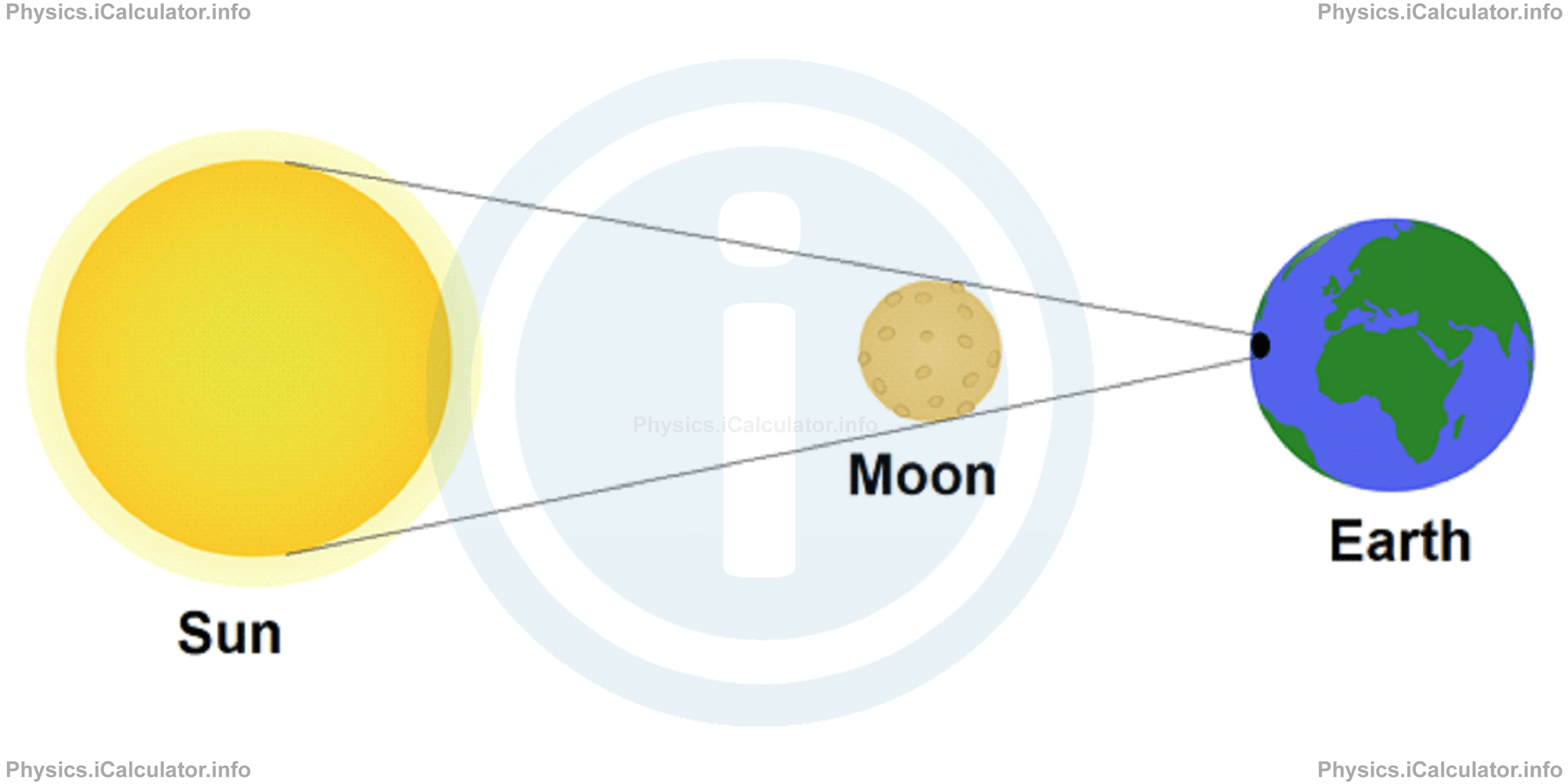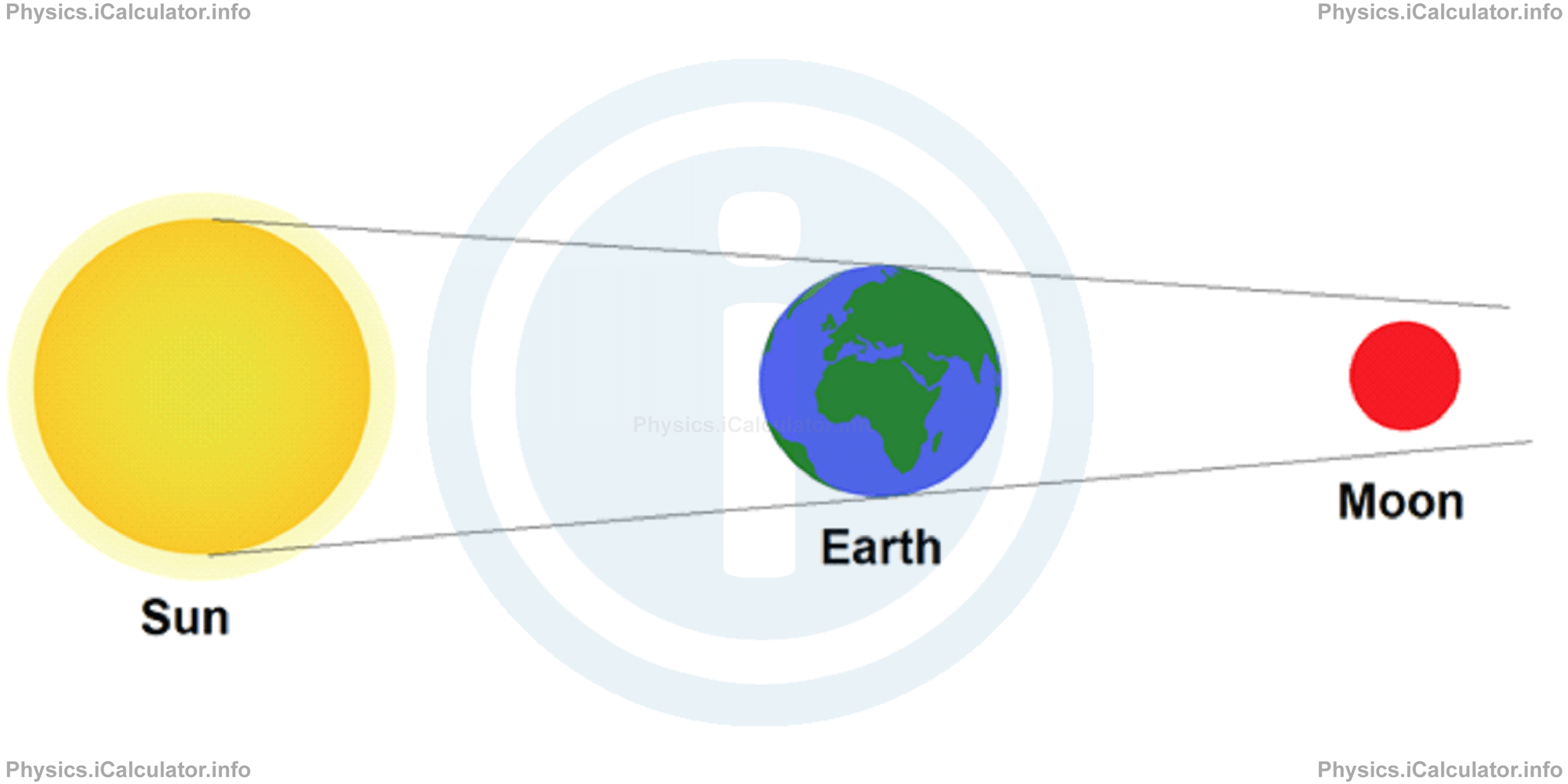Menu
Physics Lesson 22.3.3 - Eclipses
Please provide a rating, it takes seconds and helps us to keep this resource free for all to use
Welcome to our Physics lesson on Eclipses, this is the third lesson of our suite of physics lessons covering the topic of The Moon's Movement. Eclipses. Calendars, you can find links to the other lessons within this tutorial and access additional physics learning resources below this lesson.
Eclipses
An eclipse is an obscuring of the light from one celestial body by the passage of another between it and the observer or between it and its source of illumination. The orbital plane of the Moon forms an angle of 5° 9' on average to that of Earth. This small angle is the reason why eclipses occur.
There are two types of eclipses occurring on Earth surface. They are the solar and lunar eclipses. Let's get a closer look at both of them.
1. Solar eclipse
This kind of eclipse occurs when the Moon is between the Sun and the Earth. During this process, less sunlight than usual falls on a certain region of the Earth and the environment darkens, this event may occur during the daytime. At this moment the Moon is at perihelion (at the shortest distance from the Earth), view of the Sun may be blocked completely, despite the Suns' dimensions being much larger than those of the Moon. This phenomenon is known as the total solar eclipse. It may only be visible in certain regions of the Earth. In other regions where not all sunlight is blocked by the Moon, we have a partial solar eclipse, as shown in the figure below.

The dark region shown on the figure by black colour represents a total solar eclipse. Thus, where no sunlight is incident in that region while the rest of the Earth experiences a partial solar eclipse as sunlight is blocked only partially.
The duration of a solar eclipse lasts from a few minutes (for total solar eclipse) to a few hours (partial solar eclipse) as both the Earth and Moon shift from the actual position as both of them transition in their respective orbits.
The maximum diameter of shadow formed by total solar eclipse is 250 km. It shifts across various location of the Earth, providing a spectacular event, where the stars can be observed in the sky during daytime. The solar corona, protuberances and chromosphere surrounding the Moon disc are only visible from the Sun.
In a partial solar eclipse the Sun is not completely blocked but it looks like a bitten orange. This view is visible in regions extending up to a few thousands km. When a solar eclipse ends, this means the shadow is no longer formed on the Earth surface but in other regions of space.
A solar eclipse is a rare phenomenon; it occurs when the Moon is precisely between the Sun and the Earth. Theoretically, a solar eclipse may occur once a month. However, in most cases, this phenomenon cannot occur because as explained earlier, there is a shift of about 5° in orbital plane of the Moon in respect to that of the Earth. This makes the Moon shadow miss the Earth surface even if the Moon is between the Sun and the Earth.
2. Lunar eclipse
This phenomenon occurs when the Earth is between the Sun and the Moon. During this event, the Moon take a reddish colour because the red radiation emitted by the Sun is the most malleable type of radiation pertaining to visible light. Thus, we see a dark-red Moon instead of a black one.

Like a solar eclipse, lunar eclipses may be total or partial as well. Thus, when the red colour covers the entire Moon, we have a total lunar eclipse. When the red colour only appears in a certain part of the Moon, we have a partial lunar eclipse.
You have reached the end of Physics lesson 22.3.3 Eclipses. There are 5 lessons in this physics tutorial covering The Moon's Movement. Eclipses. Calendars, you can access all the lessons from this tutorial below.
More The Moon's Movement. Eclipses. Calendars Lessons and Learning Resources
Whats next?
Enjoy the "Eclipses" physics lesson? People who liked the "The Moon's Movement. Eclipses. Calendars lesson found the following resources useful:
- Eclipses Feedback. Helps other - Leave a rating for this eclipses (see below)
- Cosmology Physics tutorial: The Moon's Movement. Eclipses. Calendars. Read the The Moon's Movement. Eclipses. Calendars physics tutorial and build your physics knowledge of Cosmology
- Cosmology Revision Notes: The Moon's Movement. Eclipses. Calendars. Print the notes so you can revise the key points covered in the physics tutorial for The Moon's Movement. Eclipses. Calendars
- Cosmology Practice Questions: The Moon's Movement. Eclipses. Calendars. Test and improve your knowledge of The Moon's Movement. Eclipses. Calendars with example questins and answers
- Check your calculations for Cosmology questions with our excellent Cosmology calculators which contain full equations and calculations clearly displayed line by line. See the Cosmology Calculators by iCalculator™ below.
- Continuing learning cosmology - read our next physics tutorial: Stars
Help others Learning Physics just like you
Please provide a rating, it takes seconds and helps us to keep this resource free for all to use
We hope you found this Physics lesson "The Moon's Movement. Eclipses. Calendars" useful. If you did it would be great if you could spare the time to rate this physics lesson (simply click on the number of stars that match your assessment of this physics learning aide) and/or share on social media, this helps us identify popular tutorials and calculators and expand our free learning resources to support our users around the world have free access to expand their knowledge of physics and other disciplines.